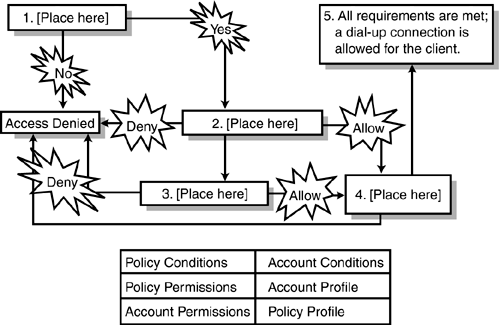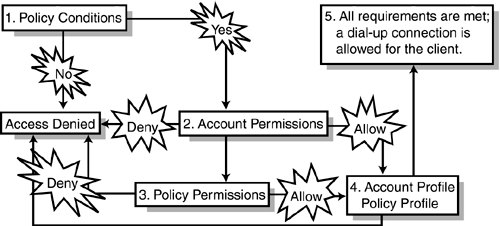Exam Layout and Design: New Case Study Format
| The format of Microsoft's Windows 2000 exams is different from that of its previous exams. For the design exams (70-219, 70-220, and 70-221), each exam consists entirely of a series of case studies and the questions can be of six types. For the Core Four exams (70-210, 70-215, 70-216, and 70-217), the same six types of questions can appear, but you are not likely to encounter complex multiquestion case studies. For design exams, each case study, or testlet , presents a detailed problem that you must read and analyze. Figure 1.1 shows an example of what a case study looks like. You must select the various tabs in the case study to view the entire case. Figure 1.1. This is how case studies appear. Following each case study is a set of questions related to the case study; these questions can be one of six types (which are discussed next ). Careful attention to the details provided in the case study is the key to success. Be prepared to toggle frequently between the case study and the questions as you work. Some of the case studies also include diagrams, which are called exhibits , that you'll need to examine closely to understand how to answer the questions. After you complete a case study, you can review all the questions and your answers. However, after you move on to the next case study, you might not be able to return to the previous case study and make any changes. The six types of question formats are
Multiple-Choice Question FormatSome exam questions require you to select a single answer, whereas others ask you to select multiple correct answers. The following multiple-choice question requires you to select a single correct answer. Following the question is a brief summary of each potential answer and why it is either correct or incorrect.
Let's examine a question where one or more answers are possible. This type of question provides check boxes rather than radio buttons for marking all appropriate selections.
For this particular question, two answers are required. Microsoft sometimes gives partial credit for partially correct answers. For Question 2, you have to check the boxes next to items a and b to obtain credit for a correct answer. Notice that selecting the right answers also means knowing why the other answers are wrong! Build-List-and-Reorder Question FormatQuestions in the build-list-and-reorder format present two lists of items ”one on the left and one on the right. To answer the question, you must move items from the list on the right to the list on the left. The final list must then be reordered into a specific order. These questions can best be characterized as follows : "From the following list of choices, pick the choices that answer the question. Arrange the list in a certain order." To give you practice with this type of question, some questions of this type are included in this study guide. Here's an example of how they appear in this book; for a sample of how they appear on the test, see Figure 1.2. Figure 1.2. This is how build-list-and-reorder questions appear.
On an actual exam, the entire list of famous people would initially appear in the list on the right. You would move the four correct answers to the list on the left and then reorder the list on the left. Notice that the answer to the question does not include all items from the initial list. However, this might not always be the case. To move an item from the right list to the left list, first select the item by clicking it and then click the Add button (left arrow). After you move an item from one list to the other, you can move the item back by first selecting the item and then clicking the appropriate button (either the Add button or the Remove button). After items have been moved to the left list, you can reorder an item by selecting the item and clicking the Up or Down button. Create-a-Tree Question FormatQuestions in the create-a-tree format also present two lists ”one on the left side of the screen and one on the right side. The list on the right consists of individual items, and the list on the left consists of nodes in a tree. To answer the question, you must move items from the list on the right to the appropriate node in the tree. These questions can best be characterized as simply a matching exercise. Items from the list on the right are placed under the appropriate category in the list on the left. Here's an example of how they appear in this book; for a sample of how they appear on the test, see Figure 1.3. Figure 1.3. This is how create-a-tree questions appear.
In this case, all the items in the list were used. However, this might not always be the case. To move an item from the right list to its appropriate location in the tree, you must first select the appropriate tree node by clicking it. Then, you select the item to be moved and click the Add button. If one or more items have been added to a tree node, the node is displayed with a plus icon (+) to the left of the node name. You can click this icon to expand the node and view the item(s) that have been added. If any item has been added to the wrong tree node, you can remove it by selecting it and clicking the Remove button. Drag-and-Connect Question FormatQuestions in the drag-and-connect format present a group of objects and a list of "connections." To answer the question, you must move the appropriate connections between the objects. This type of question is best described using graphics. Here's an example.
For this type of question, it's not necessary to use every object, and each connection can be used multiple times. Select-and-Place Question FormatQuestions in the select-and-place (drag-and-drop) format present a diagram with blank boxes and a list of labels that need to be dragged to correctly fill in the blank boxes. To answer the question, you must move the labels to their appropriate positions on the diagram. This type of question is best described using graphics. Here's an example.
|
EAN: 2147483647
Pages: 148





